Picto Diary - 09 May 2016 - Immigration and Growth
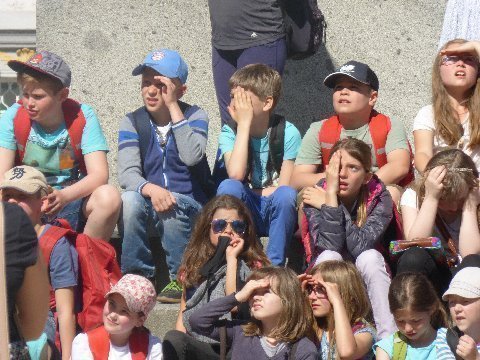
Above: German school kids. Outside St. Stephen's Cathedral. Passau, Germany. 09 May 2016.
German kids! What a surprise.
A study published by the BBC on 29 May 2015 noted that Germany had surpassed Japan for having the lowest birthrates in the world: 8.2 children per 1000 inhabitants, or, less than 1.3 births per fertile female. Japan is 8.4 and 1.4 respectively. To replace population requires a birthrate of 2.1 children per fertile female.
With its overall population aging, Germany faces two problems: First there will be few workers down the road to support its social welfare systems, on which future retirees expect to depend. Second... slowing population growth, all things being equal, will lead to labor market shortages, where the cost of labor will rise rapidly and damage the German economy and its competitiveness in the world market place.
So... Angela Merkel's 2015 initiative to invite into Germany over a million middle eastern refugees, while couched in the language of charity and generosity, is in fact rooted in economic necessity. With no labor force coming through the German birth pipeline, the difference needs to be made up with immigrants.
The issue then, becomes: "culture." Can the German culture assimilate all of the immigrants so as to absorb the German cultural ethic, or will immigrants set up their own cultural enclaves, remaining first and foremost Middle Eastern, and not German?
This latter... ie. inviting in immigrants who do not adopt local cultural norms, practices and traits, results in multiculturalism, tantamount to a slow relinquishment of sovereignty if and when the "new" culture, its laws, mores and practices, become predominant.
Angela Merkel, to quell rising citizen resistance to massive immigration from the middle east, has proclaimed that immigrants will be expected to learn German and abide by German laws an customs. Ie. "German only!" "German only?!!!!" How xenophobic of her!
Whether Germany can keep "cultural problems" arising from growing immigration under control remains to be seen. Throughout Europe, middle eastern immigrants living in their own cultural enclaves is more the norm rather than the exception. Voire... in Brussels or XXX arrondisement in Marseilles.
Need for economic growth via immigration to grow the work force is a central issue throughout Europe, not just Germany, today. Will European countries be able to keep their economies growing with the help of immigrants, without experiencing cultural clash that derails the train?
Note: US birth rate is about 1.9... higher than Germany, but still below replacement. The US continues to grow its population via immigration. The US has a better (and longer) track record of assimilating immigrants than does Europe. Necessity is the mother of invention. Perhaps Europe will have success emulating the US immigration model. Japan has never invited immigrants into its country. Without radical increases in productivity... and who's to say this can't be achieved... Japan is not far from entering secular economic decline as its population shrinks.
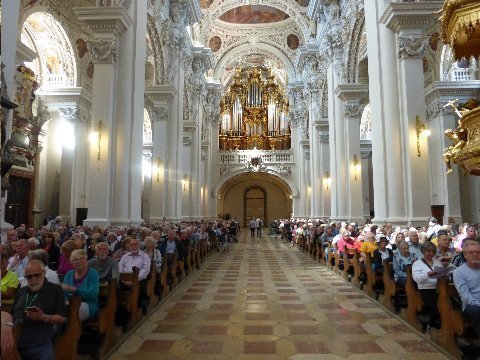
Above: Organ. St. Stephen's Cathedral. Passau, Germany. 09 May 2016.
With 17,974 pipes and 233 registers (stops) the organ is the world's largest cathedral organ. All five parts of the organ can be played from the main console.
There are larger organs... but, all are outside of cathedrals.
The pipe organ in the LDS Conference Center in Salt Lake City is larger. Our guide, a local lady of a certain age was a cheerleader for St. Stephens, though. She said she'd been to Salt Lake City to hear the LDS Conference Center organ and that it didn't pass muster compared to the "authentic," cathedral sound of St. Stephens.
The First Congregational Church of Los Angeles, CA claims to have "the largest church pipe organ in the world."
This one sounded pretty good to me. All stops open, chords resplendent.... I tear up. The reverberations after the organist takes his hands off the keys are breathtaking in the 300 year old church.
My favorite of the four numbers played today was a suite, Aus Livre d'Orgue by Pierre du Mage (1676-1751). In the final of four movements, "Grand Jeu": Huge major cords... huge reverberations. Tears. We're talking high church, here, folks.
From the Third Reich, yesterday in Nuremburg, to Renaissance Catholicism today in Passau. For me, of course, the two should not be conflated. But, both movements certainly understood imagery... the Nazis with their huge parade grounds, massive architecture and ceremonial pomp... and the Catholics with their magnificent cathedrals and organ music.
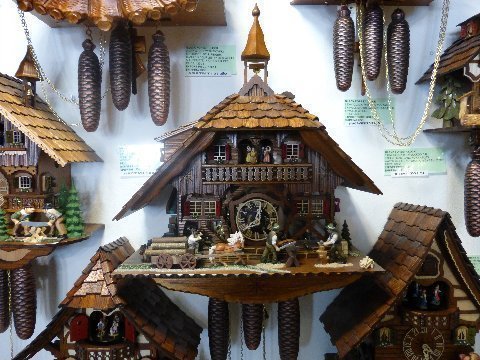
Above: Cuckoo-clock. Heidi and Peter's Ladl. Domplatz, Passau, Germany. 09 May 2016.
There are a half dozen riverboats at the Passau dock. One gets the impression that the local stores, restaurants and coffee houses are doing a good business from the tourists. Locals I see, perhaps not directly involved in the tourist trade, seem... well, "resigned." Passau seems little different from other cruise ports... Skagway, Caymans...Greek Islands.... wherever there is a cruise boat. Havana, next.
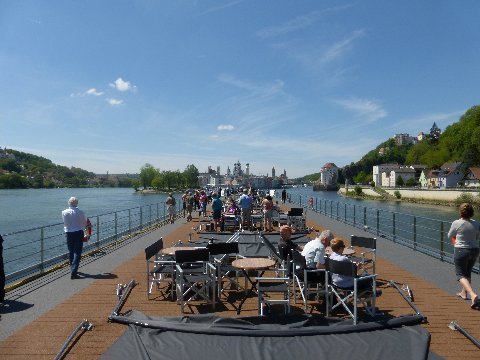
Above: Conjunction of three rivers at Passau: Left, Inn; center, Danube, and right, Ilz. Passau, Germany. 09 May 2016.
Image looks astern from Tauck Savor river boat sun deck, to city of Passau, upstream towards the three river confluence. St. Stephen's Cathedral, a baroque church, is the largest edifice in the distance.
The river continues as the Danube, passing through Austria, Hungary and Romania before reaching the Black Sea at Constanta.
TIMDT and Mwah (sic) were in Constanta, Romania's Black Sea port, about two years ago.
The Danube is navigable from the Black Sea all the way (with the help of a couple of canals, to Amsterdam, Holland, a distance of 2000 miles.
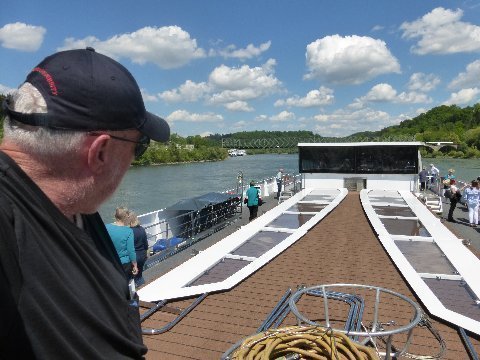
Above: The Bishop aboard the Tauck Savor. 09 May 2016.
Image looks over the bow, upstream of Passau, Germany, now receding into the distance.
Spectacular weather for river cruising. 72 degrees and mostly sunny.
My first observation about the difference between river cruising and ocean cruising is that the river boat captain has to be navigating/steering the riverboat constantly. The river meanders and there are locks along the way. The sea captain, charts a course and puts the ship on auto pilot. Of course crew are looking at radar watching for obstacles in the water notwithstanding the ship's "piloting itself."
After leaving Passau, Germany, the Danube entered Austria. TIMDT observed that cruising down the river reminded her of cruising the Norway fjords. As we sit in our port side cabin, we look full length and height windows at the passing Austrian country side.
I see people seated along the banks of the river. Sometimes, when we cruise by a town, there is a park along the river bank. I am reminded of the times when Sabey and Mwah (sic), LDS missionaries assigned in 1967 to Nogent sur Marne, in the eastern Paris banlieu, would have lunch seated in the grass alongside the Marne, watching the river traffic. A typical lunch was a baguette and some gruyere cheese, washed down by a concoction then called "limonade," but more like tonic water.
Addendum:
Hi Steve,
Sounds like a great trip. We visited Jane and Bill .... (Citi Singapore) when they were living in Prague a couple of decades ago. It is a great little city which was spared the devastation of WW2. I was stationed for three years in Germany and know some of the area you will be visiting very well.
Christy and I are also off on a bucket list trip. We leave on Monday to walk the Camino de Santiago. After we spend a week in Portugal, drive through northern Spain, then a long week around Southwestern France. We finish up with a week in Ireland, half with my daughter’s family and half in Dublin. (After training in London, Dublin was my first posting with Citi so will be catching up with several retired Citibankers. Jim ...., former CCO, was my first real boss in Citi.)
Many of the folks on the Park Citi list are old friends. It is great that you have made us all connect.
Have a great cruise.
Dean, Miami, FL